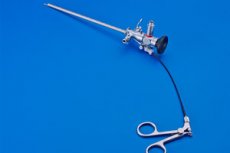Medical expert of the article
New publications
Vaginoscopy
Last reviewed: 03.07.2025

All iLive content is medically reviewed or fact checked to ensure as much factual accuracy as possible.
We have strict sourcing guidelines and only link to reputable media sites, academic research institutions and, whenever possible, medically peer reviewed studies. Note that the numbers in parentheses ([1], [2], etc.) are clickable links to these studies.
If you feel that any of our content is inaccurate, out-of-date, or otherwise questionable, please select it and press Ctrl + Enter.

The method of endoscopic examination of the vagina during gynecological examination of sexually mature women is colposcopy, and such a diagnostic procedure as vaginoscopy can be performed on girls and young women with an intact hymen - the hymen surrounding the vaginal opening.
Indications for the procedure
Endoscopic examination of the vagina – vaginoscopy for children: prepubertal girls and teenage girls after menarche – is prescribed quite rarely. [ 1 ] These cases concern:
- vaginal bleeding;
- vaginal discharge;
- chronic vulvovaginitis in girls (especially if the infection does not respond to treatment);
- recurrent sexually transmitted infections, for example, vaginoscopy in children with gonorrhea is necessary to assess the condition of the mucous epithelium, including that covering the vaginal part of the cervix;
- pelvic pain of unknown etiology;
- diagnostics of vaginal and uterine malformations with symptoms of congenital vaginal anomalies (for example, vaginal stenosis or transverse vaginal septum) - when visual examination of the vaginal vestibule and transabdominal ultrasound are not informative enough;
- suspicion of the presence of a foreign body in the vagina or its traumatic injury due to possible sexual violence. [ 2 ], [ 3 ]
Read also – Features of gynecological examination of children and adolescents
Preparation
Parents (in particular, the girl's mother) should be informed about the purpose of this diagnostic procedure, as well as that the hymen will not be injured during its implementation.
And the patient’s preparation consists of cleansing the intestines (using an enema, which is done in the morning before the examination) and emptying the bladder.
Before the procedure, a broad-spectrum antibiotic is administered to prevent infections.
Technique vaginoscopies
Vaginoscopy is performed on girls on an outpatient basis or in a day hospital of a medical institution – under general anesthesia.
The technique eliminates the need to use conventional gynecological instruments (speculums). Equipped with a miniature video camera at the end, a flexible fiber-optic vaginoscope (pediatric cystoscope or flexible irrigation endoscope) of small diameter is carefully inserted into the vagina through the natural opening of the hymen (the intact hymen almost never covers the entire vagina) - without damaging it. [ 4 ]
As the camera films the inside of the vagina, the doctor sees everything on a monitor.
Complications after the procedure
As a rule, there are no negative consequences of vaginoscopy, but a feeling of discomfort and trauma to the vaginal mucosa are possible. At the same time, during the first few days, minor pain above the pubis may occur, and there may be a small amount of blood in the urine. Nausea and vomiting after anesthesia are also possible. [ 5 ]
Complications occur due to infection of the vagina and urinary tract or damage to the hymen.
Reviews
According to pediatric gynecologists, the use of diagnostic vaginoscopy – a painless and safe method for assessing the condition of the lower genital tract – is advisable for making a correct diagnosis and adequate treatment of gynecological diseases in childhood and adolescence.

